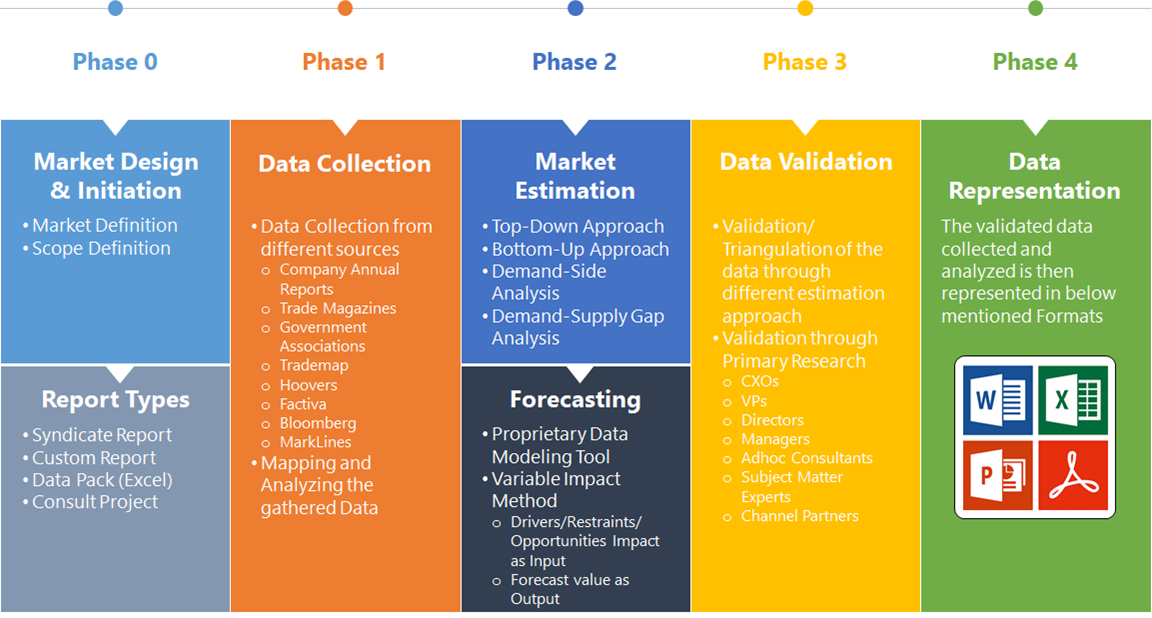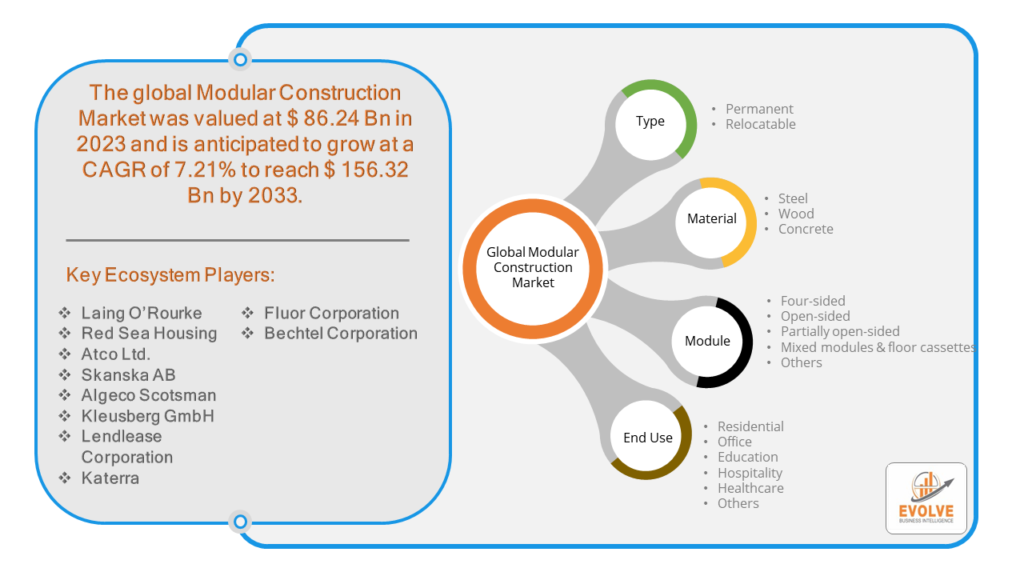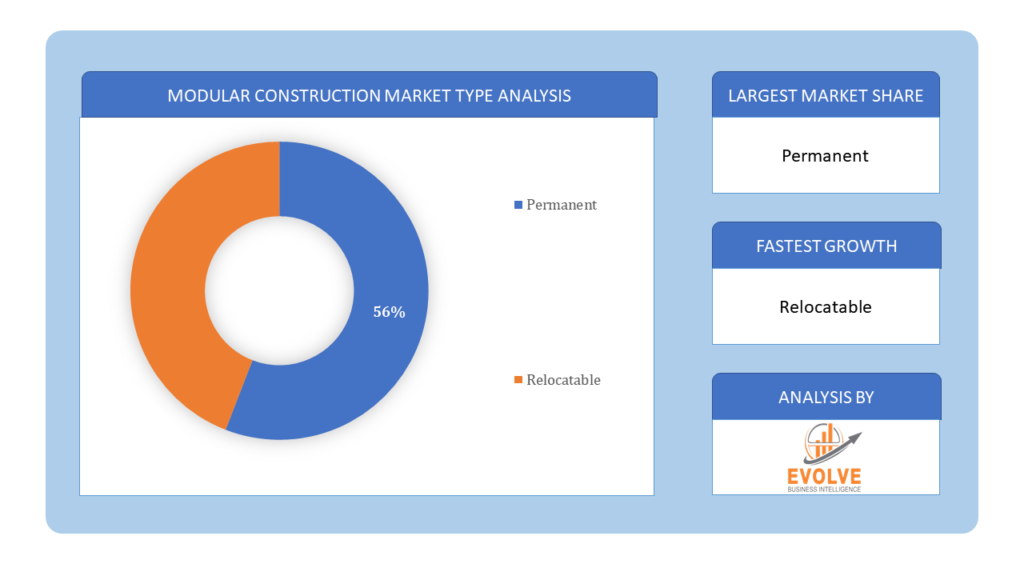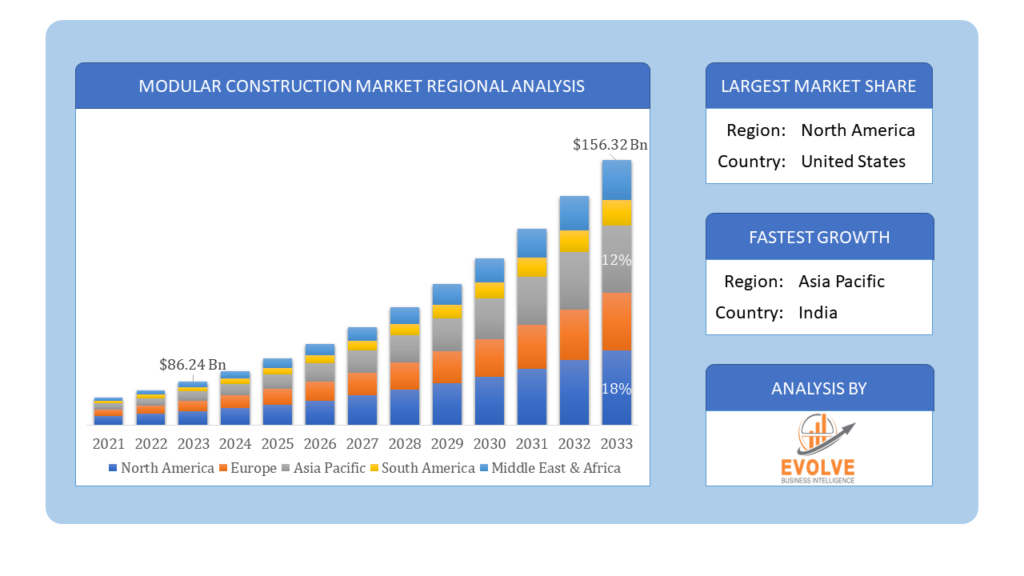Modular Construction Market Analysis and Global Forecast 2023-2033
$ 1,390.00 – $ 5,520.00Price range: $ 1,390.00 through $ 5,520.00
Modular Construction Market Research Report: By Type (Permanent, Relocatable), By Material (Steel, Wood, Concrete), By Module (Four-sided, Open-sided, Partially open-sided, Mixed modules & floor cassettes, Others), By End Use (Residential, Office, Education, Hospitality, Healthcare, Others), and by Region — Forecast till 2033
Page: 165
Modular Construction Market Overview
Modular Construction Market Size is expected to reach USD 156.32 Billion by 2033. The Modular Construction industry size accounted for USD 86.24 Billion in 2023 and is expected to expand at a compound annual growth rate (CAGR) of 7.21% from 2023 to 2033. The modular construction market involves the use of prefabricated building units that are manufactured off-site and then assembled on-site to create a structure. This method offers several advantages, including reduced construction time, lower labor costs, improved quality control, and decreased environmental impact. It’s increasingly popular in various sectors such as residential, commercial, healthcare, and education due to its efficiency and sustainability benefits. The market is driven by the growing demand for affordable housing, rapid urbanization, and advancements in building technologies.
Global Modular Construction Market Synopsis
The COVID-19 pandemic has led to supply chain disruptions leading to supply shortages or lower demand in the Modular Construction market. The travel restrictions and social-distancing measures have resulted in a sharp drop in consumer and business spending and this pattern is to continue for some time. The end-user trend and preferences have changed due to the pandemic and have resulted in manufacturers, developers, and service providers to adopt various strategies to stabilize the company.
Global Modular Construction Market Dynamics
The major factors that have impacted the growth of Modular Construction are as follows:
Drivers:
⮚ Technological Advancements
Innovations in design software, building materials, and construction techniques have greatly enhanced the capabilities of modular construction. Advanced Building Information Modeling (BIM) systems allow for precise planning and coordination, while new materials and manufacturing technologies improve the durability and performance of modular units. These advancements make modular construction a more viable and attractive option for a wide range of projects.
Restraint:
- High Initial Investment
While modular construction can result in cost savings over the project lifecycle, the initial capital investment required for setting up manufacturing facilities, acquiring advanced machinery, and training the workforce can be significant. This high upfront cost can be a barrier for smaller construction firms and developers who may lack the necessary financial resources.
Opportunity:
⮚ Technological Innovations
Advances in technology, such as Building Information Modeling (BIM), automation, and robotics, are driving efficiency and innovation in modular construction. These technologies improve design accuracy, streamline production processes, and enhance quality control. By continuously integrating new technologies, the modular construction market can increase its competitiveness and expand its capabilities to take on more complex and diverse projects.
Modular Construction Market Segment Overview
By Type
Based on the Type, the market is segmented based on Permanent and Relocatable. The PMC segment dominates the market due to its durability, aesthetic appeal, and sustainability, with a projected CAGR of 6.6% over the forecast period
By Material
Based on Material, the market has been divided into Steel, Wood, Concrete. The steel segment is expected to dominate the market due to its strength, durability, and suitability for various applications like parking lots, commercial buildings, mixed-use developments, and residential housing
By Module
Based on the Module, the market has been divided into Four-sided, Open-sided, Partially open-sided, Mixed modules & floor cassettes, Others. The four-sided module type is expected to dominate the market due to its versatility and ability to accommodate various building designs.
By End Use
Based on End Use, the market has been divided into Residential, Office, Education, Hospitality, Healthcare, Others. The healthcare segment is expected to grow rapidly due to the need for silence, safety, and cleanliness in medical facilities, which modular buildings can provide
Global Modular Construction Market Regional Analysis
Based on region, the market has been divided into North America, Europe, Asia-Pacific, the Middle East & Africa, and Latin America. The area of Asia-Pacific is anticipated to dominate the market for the usage of Modular Construction, followed by those in Asia-Pacific and Europe.
 Modular Construction Asia-Pacific Market
Modular Construction Asia-Pacific Market
The Asia-Pacific region holds a dominant position in the Modular Construction market. Asia-Pacific and the Global Remainder. The Asia Pacific Modular Construction Market was valued at USD 35.8 billion in 2021 and is anticipated to expand at a substantial compound annual growth rate (CAGR) throughout the course of the study. The building industry’s growth is the cause of the rising demand from the residential and commercial sectors. Furthermore, the government’s vigorous efforts to promote eco-friendly housing are driving higher demand for modular homes. India’s booming commercial building industry would result in the highest compound annual growth rate.
Modular Construction North America Market
The North America region is witnessing rapid growth and emerging as a significant market for the Modular Construction industry. The second-fastest-growing market was the modular construction sector in North America. Decreased investments have further led to a decline in the non-residential sector, which is resulting in an only modest development of the building industry in North America. Developed and inhabited by superpowers such as the United States and Canada,
Competitive Landscape
The competitive landscape includes key players (tier 1, tier 2, and local) having a presence across the globe. Companies such as Laing O’Rourke, Red Sea Housing, Atco Ltd., Skanska AB, and Algeco Scotsman are some of the leading players in the global Modular Construction Industry. These players have adopted partnership, acquisition, expansion, and new product development, among others as their key strategies.
Key Market Players:
- Laing O’Rourke
- Red Sea Housing
- Atco Ltd.
- Skanska AB
- Algeco Scotsman
- Kleusberg GmbH
- Lendlease Corporation
- Katerra
- Fluor Corporation
- Bechtel Corporation
Key Development:
In September 2022, Red Sea Housing announced a key development in modular construction by launching a new manufacturing facility in Saudi Arabia aimed at expanding its capacity to produce modular units for residential and commercial projects.
Scope of the Report
Global Modular Construction Market, by Type
- Permanent
- Relocatable
Global Modular Construction Market, by Material
- Steel
- Wood
- Concrete
Global Modular Construction Market, by Module
- Four-sided
- Open-sided
- Partially open-sided
- Mixed modules & floor cassettes
- Others
Global Modular Construction Market, by End Use
- Residential
- Office
- Education
- Hospitality
- Healthcare
- Others
Global Modular Construction Market, by Region
- North America
- US
- Canada
- Mexico
- Europe
- UK
- Germany
- France
- Italy
- Spain
- Benelux
- Nordic
- Rest of Europe
- Asia Pacific
- China
- Japan
- South Korea
- Indonesia
- Austalia
- Malaysia
- India
- Rest of Asia Pacific
- South America
- Brazil
- Argentina
- Rest of South America
- Middle East & Africa
- Saudi Arabia
- UAE
- Egypt
- South Africa
- Rest of Middle East & Africa
| Parameters | Indicators |
|---|---|
| Market Size | 2033: $156.32 Billion |
| CAGR | 7.21% CAGR (2023-2033) |
| Base year | 2022 |
| Forecast Period | 2023-2033 |
| Historical Data | 2021 |
| Report Coverage | Revenue Forecast, Competitive Landscape, Growth Factors, and Trends |
| Key Segmentations | Type, Material, Module, End Use |
| Geographies Covered | North America, Europe, Asia-Pacific, Latin America, Middle East, Africa |
| Key Vendors | Laing O’Rourke, Red Sea Housing, Atco Ltd., Skanska AB, Algeco Scotsman, Kleusberg GmbH, Lendlease Corporation, Katerra, Fluor Corporation, Bechtel Corporation |
| Key Market Opportunities | Green structures and homes that are modular and panelized |
| Key Market Drivers | Increased industrialization, urbanization Energy-efficient building, &cost-effective construction |
REPORT CONTENT BRIEF:
- High-level analysis of the current and future Modular Construction Industry trends and opportunities
- Detailed analysis of current market drivers, restraining factors, and opportunities analysis in the future
- Historical market size for the year 2021, and forecast from 2023 to 2033
- Modular Construction market share analysis for each segment
- Competitor analysis with a comprehensive insight into its product segment, financial strength, and strategies adopted.
- Identifies key strategies adopted by the key players including new product development, mergers and acquisitions, joint ventures, collaborations, and partnerships.
- To identify and understand the various factors involved in the global Modular Construction market affected by the pandemic
- To provide year-on-year growth from 2022 to 2033
- To provide short-term, long-term, and overall CAGR comparison from 2022 to 2033.
- Provide Total Addressable Market (TAM) for the Global Modular Construction Market.
Press Release

Global Pharmaceutical Manufacturing Market to Reach $1.38 Trillion by 2035 with 7.35% CAGR, New Research Shows

The Global Mammography Market Is Estimated To Record a CAGR of Around 10.29% During The Forecast Period

Glue Stick Market to Reach USD 2.35 Billion by 2034

Podiatry Service Market to Reach USD 11.88 Billion by 2034

Microfluidics Technology Market to Reach USD 32.58 Billion by 2034

Ferric Chloride Market to Reach USD 10.65 Billion by 2034

Family Practice EMR Software Market to Reach USD 21.52 Billion by 2034

Electric Hairbrush Market to Reach USD 15.95 Billion by 2034

Daily Bamboo Products Market to Reach USD 143.52 Billion by 2034

Cross-border E-commerce Logistics Market to Reach USD 112.65 Billion by 2034
Frequently Asked Questions (FAQ)
What is the forecasted market size for the modular construction industry by 2033?
The market size is expected to reach USD 156.32 Billion by 2033, growing at a CAGR of 7.21% from 2023
What are the key advantages of modular construction?
Modular construction offers reduced construction time, lower labor costs, improved quality control, and decreased environmental impact
Which regions dominate the modular construction market?
Asia-Pacific is anticipated to dominate the market, followed by North America and Europe
How has COVID-19 impacted the modular construction market?
The pandemic caused supply chain disruptions, leading to supply shortages and changes in end-user trends and preferences
What are the main materials used in modular construction?
The primary materials are steel, wood, and concrete, with steel being the most dominant due to its strength and durability
Table of Content
CHAPTER 1. Executive Summary CHAPTER 2. Scope of the Study 2.1. Market Definition 2.2. Market Scope & Segmentation 2.2.1. Objective of Report CHAPTER 3. Evolve BI Methodology 3.1. Data Collection & Validation Approach 3.2. Market Size Estimation and Forecast CHAPTER 4. Exclusive Analysis 4.1. Market Opportunity Score 4.1.1. Type Segement – Market Opportunity Score 4.1.2. Material Segment – Market Opportunity Score 4.1.3. Module Segment – Market Opportunity Score 4.1.4. End Use Segment – Market Opportunity Score 4.2. Key Market Influencing Indicators CHAPTER 5. Market Insights and Trends 5.1. Value Chain Analysis 5.1.1. Type 5.1.2. Manufacturing Process 5.1.3. Distribution Channel 5.1.4. End User 5.2. Porter’s Five Forces Analysis 5.2.1. Bargaining Power of Buyers 5.2.2. Bargaining Power of Suppliers 5.2.3. Threat of New Entrant 5.2.4. Threat of Substitute 5.2.5. Industry Rivalry 5.3. COVID-19 Impact and Post COVID Scenario on Modular Construction Market 5.3.1. Impact of COVID-19 5.3.2. Government Support and Industry Revival Policies 5.3.3. Measures Taken by Companies to Mitigate Negative Impact 5.3.4. Post COVID Trend CHAPTER 6. MArket Dynamics 6.1. Introduction 6.2. Drivers 6.2.1. Driver 1 6.2.2. Driver 2 6.2.3. Driver 3 6.3. Restraints 6.3.1. Restraint 1 6.3.2. Restraint 2 6.4. Opportunity 6.4.1. Opportunity 1 CHAPTER 7. Global Modular Construction Market, By Type 7.1. Introduction 7.1.1. Permanent 7.1.2. Relocatable CHAPTER 8. Global Modular Construction Market, By Material 8.1. Introduction 8.1.1. Steel 8.1.2. Wood 8.1.3. Concrete CHAPTER 9. Global Modular Construction Market, By Module 9.1. Introduction 9.1.1. Four-sided 9.1.2. Open-sided 9.1.3. Partially open-sided 9.1.4. Mixed modules & floor cassettes 9.1.5. Others CHAPTER 10. Global Modular Construction Market, By End Use 10.1. Introduction 10.1.1. Residential 10.1.2. Office 10.1.3. Education 10.1.4. Hospitality 10.1.5. Healthcare 10.1.6. Others CHAPTER 11. Global Modular Construction Market, By Region 11.1. Introduction 11.2. NORTH AMERICA 11.2.1. North America: Market Size and Forecast, By Country, 2023 – 2033 ($ Million) 11.2.2. North America: Market Size and Forecast, By Type, 2023 – 2033 ($ Million) 11.2.3. North America: Market Size and Forecast, By Material, 2023 – 2033 ($ Million) 11.2.4. North America: Market Size and Forecast, By Module, 2023 – 2033 ($ Million) 11.2.5. North America: Market Size and Forecast, By End Use, 2023 – 2033 ($ Million) 11.2.6. US 11.2.6.1. US: Market Size and Forecast, By Type, 2023 – 2033 ($ Million) 11.2.6.2. US: Market Size and Forecast, By Material, 2023 – 2033 ($ Million) 11.2.6.3. US: Market Size and Forecast, By Module, 2023 – 2033 ($ Million) 11.2.6.4. US: Market Size and Forecast, By End Use, 2023 – 2033 ($ Million) 11.2.7. CANADA 11.2.7.1. Canada: Market Size and Forecast, By Type, 2023 – 2033 ($ Million) 11.2.7.2. Canada: Market Size and Forecast, By Material, 2023 – 2033 ($ Million) 11.2.7.3. Canada: Market Size and Forecast, By Module, 2023 – 2033 ($ Million) 11.2.7.4. Canada: Market Size and Forecast, By End Use, 2023 – 2033 ($ Million) 11.2.8. MEXICO 11.2.8.1. Mexico: Market Size and Forecast, By Type, 2023 – 2033 ($ Million) 11.2.8.2. Mexico: Market Size and Forecast, By Material, 2023 – 2033 ($ Million) 11.2.8.3. Mexico: Market Size and Forecast, By Module, 2023 – 2033 ($ Million) 11.2.8.4. Mexico: Market Size and Forecast, By End Use, 2023 – 2033 ($ Million) 11.3. Europe 11.3.1. Europe: Market Size and Forecast, By Country, 2023 – 2033 ($ Million) 11.3.2. Europe: Market Size and Forecast, By Type, 2023 – 2033 ($ Million) 11.3.3. Europe: Market Size and Forecast, By Material, 2023 – 2033 ($ Million) 11.3.4. Europe: Market Size and Forecast, By Module, 2023 – 2033 ($ Million) 11.3.5. Europe: Market Size and Forecast, By End Use, 2023 – 2033 ($ Million) 11.3.6. U.K. 11.3.6.1. U.K.: Market Size and Forecast, By Type, 2023 – 2033 ($ Million) 11.3.6.2. U.K.: Market Size and Forecast, By Material, 2023 – 2033 ($ Million) 11.3.6.3. U.K.: Market Size and Forecast, By Module, 2023 – 2033 ($ Million) 11.3.6.4. U.K.: Market Size and Forecast, By End Use, 2023 – 2033 ($ Million) 11.3.7. GERMANY 11.3.7.1. Germany: Market Size and Forecast, By Type, 2023 – 2033 ($ Million) 11.3.7.2. Germany: Market Size and Forecast, By Material, 2023 – 2033 ($ Million) 11.3.7.3. Germany: Market Size and Forecast, By Module, 2023 – 2033 ($ Million) 11.3.7.4. Germany: Market Size and Forecast, By End Use, 2023 – 2033 ($ Million) 11.3.8. FRANCE 11.3.8.1. France: Market Size and Forecast, By Type, 2023 – 2033 ($ Million) 11.3.8.2. France: Market Size and Forecast, By Material, 2023 – 2033 ($ Million) 11.3.8.3. France: Market Size and Forecast, By Module, 2023 – 2033 ($ Million) 11.3.8.4. France: Market Size and Forecast, By End Use, 2023 – 2033 ($ Million) 11.3.9. ITALY 11.3.9.1. Italy: Market Size and Forecast, By Type, 2023 – 2033 ($ Million) 11.3.9.2. Italy: Market Size and Forecast, By Material, 2023 – 2033 ($ Million) 11.3.9.3. Italy: Market Size and Forecast, By Module, 2023 – 2033 ($ Million) 11.3.9.4. Italy: Market Size and Forecast, By End Use, 2023 – 2033 ($ Million) 11.3.10. SPAIN 11.3.10.1. Spain: Market Size and Forecast, By Type, 2023 – 2033 ($ Million) 11.3.10.2. Spain: Market Size and Forecast, By Material, 2023 – 2033 ($ Million) 11.3.10.3. Spain: Market Size and Forecast, By Module, 2023 – 2033 ($ Million) 11.3.10.4. Spain: Market Size and Forecast, By End Use, 2023 – 2033 ($ Million) 11.3.11. BENELUX 11.3.11.1. BeNeLux: Market Size and Forecast, By Type, 2023 – 2033 ($ Million) 11.3.11.2. BeNeLux: Market Size and Forecast, By Material, 2023 – 2033 ($ Million) 11.3.11.3. BeNeLux: Market Size and Forecast, By Module, 2023 – 2033 ($ Million) 11.3.11.4. BeNeLux: Market Size and Forecast, By End Use, 2023 – 2033 ($ Million) 11.3.12. RUSSIA 11.3.12.1. Russia: Market Size and Forecast, By Type, 2023 – 2033 ($ Million) 11.3.12.2. Russia: Market Size and Forecast, By Material, 2023 – 2033 ($ Million) 11.3.12.3. Russia: Market Size and Forecast, By Module, 2023 – 2033 ($ Million) 11.3.12.4. Russia: Market Size and Forecast, By End Use, 2023 – 2033 ($ Million) 11.3.13. REST OF EUROPE 11.3.13.1. Rest of Europe: Market Size and Forecast, By Type, 2023 – 2033 ($ Million) 11.3.13.2. Rest of Europe: Market Size and Forecast, By Material, 2023 – 2033 ($ Million) 11.3.13.3. Rest of Europe: Market Size and Forecast, By Module, 2023 – 2033 ($ Million) 11.3.13.4. Rest of Europe: Market Size and Forecast, By End Use, 2023 – 2033 ($ Million) 11.4. Asia Pacific 11.4.1. Asia Pacific: Market Size and Forecast, By Country, 2023 – 2033 ($ Million) 11.4.2. Asia Pacific: Market Size and Forecast, By Type, 2023 – 2033 ($ Million) 11.4.3. Asia Pacific: Market Size and Forecast, By Material, 2023 – 2033 ($ Million) 11.4.4. Asia Pacific: Market Size and Forecast, By Module, 2023 – 2033 ($ Million) 11.4.5. Asia Pacific: Market Size and Forecast, By End Use, 2023 – 2033 ($ Million) 11.4.6. CHINA 11.4.6.1. China: Market Size and Forecast, By Type, 2023 – 2033 ($ Million) 11.4.6.2. China: Market Size and Forecast, By Material, 2023 – 2033 ($ Million) 11.4.6.3. China: Market Size and Forecast, By Module, 2023 – 2033 ($ Million) 11.4.6.4. China: Market Size and Forecast, By End Use, 2023 – 2033 ($ Million) 11.4.7. JAPAN 11.4.7.1. Japan: Market Size and Forecast, By Type, 2023 – 2033 ($ Million) 11.4.7.2. Japan: Market Size and Forecast, By Material, 2023 – 2033 ($ Million) 11.4.7.3. Japan: Market Size and Forecast, By Module, 2023 – 2033 ($ Million) 11.4.7.4. Japan: Market Size and Forecast, By End Use, 2023 – 2033 ($ Million) 11.4.8. INDIA 11.4.8.1. India: Market Size and Forecast, By Type, 2023 – 2033 ($ Million) 11.4.8.2. India: Market Size and Forecast, By Material, 2023 – 2033 ($ Million) 11.4.8.3. India: Market Size and Forecast, By Module, 2023 – 2033 ($ Million) 11.4.8.4. India: Market Size and Forecast, By End Use, 2023 – 2033 ($ Million) 11.4.9. SOUTH KOREA 11.4.9.1. South Korea: Market Size and Forecast, By Type, 2023 – 2033 ($ Million) 11.4.9.2. South Korea: Market Size and Forecast, By Material, 2023 – 2033 ($ Million) 11.4.9.3. South Korea: Market Size and Forecast, By Module, 2023 – 2033 ($ Million) 11.4.9.4. South Korea: Market Size and Forecast, By End Use, 2023 – 2033 ($ Million) 11.4.10. THAILAND 11.4.10.1. Thailand: Market Size and Forecast, By Type, 2023 – 2033 ($ Million) 11.4.10.2. Thailand: Market Size and Forecast, By Material, 2023 – 2033 ($ Million) 11.4.10.3. Thailand: Market Size and Forecast, By Module, 2023 – 2033 ($ Million) 11.4.10.4. Thailand: Market Size and Forecast, By End Use, 2023 – 2033 ($ Million) 11.4.11. INDONESIA 11.4.11.1. Indonesia: Market Size and Forecast, By Type, 2023 – 2033 ($ Million) 11.4.11.2. Indonesia: Market Size and Forecast, By Material, 2023 – 2033 ($ Million) 11.4.11.3. Indonesia: Market Size and Forecast, By Module, 2023 – 2033 ($ Million) 11.4.11.4. Indonesia: Market Size and Forecast, By End Use, 2023 – 2033 ($ Million) 11.4.12. MALAYSIA 11.4.12.1. Malaysia: Market Size and Forecast, By Type, 2023 – 2033 ($ Million) 11.4.12.2. Malaysia: Market Size and Forecast, By Material, 2023 – 2033 ($ Million) 11.4.12.3. Malaysia: Market Size and Forecast, By Module, 2023 – 2033 ($ Million) 11.4.12.4. Malaysia: Market Size and Forecast, By End Use, 2023 – 2033 ($ Million) 11.4.13. AUSTRALIA 11.4.13.1. Australia: Market Size and Forecast, By Type, 2023 – 2033 ($ Million) 11.4.13.2. Australia: Market Size and Forecast, By Material, 2023 – 2033 ($ Million) 11.4.13.3. Australia: Market Size and Forecast, By Module, 2023 – 2033 ($ Million) 11.4.13.4. Australia: Market Size and Forecast, By End Use, 2023 – 2033 ($ Million) 11.4.14. REST FO ASIA PACIFIC 11.4.14.1. Rest fo Asia Pacific: Market Size and Forecast, By Type, 2023 – 2033 ($ Million) 11.4.14.2. Rest fo Asia Pacific: Market Size and Forecast, By Material, 2023 – 2033 ($ Million) 11.4.14.3. Rest fo Asia Pacific: Market Size and Forecast, By Module, 2023 – 2033 ($ Million) 11.4.14.4. Rest fo Asia Pacific: Market Size and Forecast, By End Use, 2023 – 2033 ($ Million) 11.5. South America 11.5.1. South America: Market Size and Forecast, By Country, 2023 – 2033 ($ Million) 11.5.2. South America: Market Size and Forecast, By Type, 2023 – 2033 ($ Million) 11.5.3. South America: Market Size and Forecast, By Material, 2023 – 2033 ($ Million) 11.5.4. South America: Market Size and Forecast, By Module, 2023 – 2033 ($ Million) 11.5.5. South America: Market Size and Forecast, By End Use, 2023 – 2033 ($ Million) 11.5.6. BRAZIL 11.5.6.1. Brazil: Market Size and Forecast, By Type, 2023 – 2033 ($ Million) 11.5.6.2. Brazil: Market Size and Forecast, By Material, 2023 – 2033 ($ Million) 11.5.6.3. Brazil: Market Size and Forecast, By Module, 2023 – 2033 ($ Million) 11.5.6.4. Brazil: Market Size and Forecast, By End Use, 2023 – 2033 ($ Million) 11.5.7. ARGENTINA 11.5.7.1. Argentina: Market Size and Forecast, By Type, 2023 – 2033 ($ Million) 11.5.7.2. Argentina: Market Size and Forecast, By Material, 2023 – 2033 ($ Million) 11.5.7.3. Argentina: Market Size and Forecast, By Module, 2023 – 2033 ($ Million) 11.5.7.4. Argentina: Market Size and Forecast, By End Use, 2023 – 2033 ($ Million) 11.5.8. REST OF SOUTH AMERICA 11.5.8.1. Rest of South America: Market Size and Forecast, By Type, 2023 – 2033 ($ Million) 11.5.8.2. Rest of South America: Market Size and Forecast, By Material, 2023 – 2033 ($ Million) 11.5.8.3. Rest of South America: Market Size and Forecast, By Module, 2023 – 2033 ($ Million) 11.5.8.4. Rest of South America: Market Size and Forecast, By End Use, 2023 – 2033 ($ Million) 11.6. Middle East & Africa 11.6.1. Middle East & Africa: Market Size and Forecast, By Country, 2023 – 2033 ($ Million) 11.6.2. Middle East & Africa: Market Size and Forecast, By Type, 2023 – 2033 ($ Million) 11.6.3. Middle East & Africa: Market Size and Forecast, By Material, 2023 – 2033 ($ Million) 11.6.4. Middle East & Africa: Market Size and Forecast, By Module, 2023 – 2033 ($ Million) 11.6.5. Middle East & Africa: Market Size and Forecast, By End Use, 2023 – 2033 ($ Million) 11.6.6. SAUDI ARABIA 11.6.6.1. Saudi Arabia: Market Size and Forecast, By Type, 2023 – 2033 ($ Million) 11.6.6.2. Saudi Arabia: Market Size and Forecast, By Material, 2023 – 2033 ($ Million) 11.6.6.3. Saudi Arabia: Market Size and Forecast, By Module, 2023 – 2033 ($ Million) 11.6.6.4. Saudi Arabia: Market Size and Forecast, By End Use, 2023 – 2033 ($ Million) 11.6.7. UAE 11.6.7.1. UAE: Market Size and Forecast, By Type, 2023 – 2033 ($ Million) 11.6.7.2. UAE: Market Size and Forecast, By Material, 2023 – 2033 ($ Million) 11.6.7.3. UAE: Market Size and Forecast, By Module, 2023 – 2033 ($ Million) 11.6.7.4. UAE: Market Size and Forecast, By End Use, 2023 – 2033 ($ Million) 11.6.8. EGYPT 11.6.8.1. Egypt: Market Size and Forecast, By Type, 2023 – 2033 ($ Million) 11.6.8.2. Egypt: Market Size and Forecast, By Material, 2023 – 2033 ($ Million) 11.6.8.3. Egypt: Market Size and Forecast, By Module, 2023 – 2033 ($ Million) 11.6.8.4. Egypt: Market Size and Forecast, By End Use, 2023 – 2033 ($ Million) 11.6.9. SOUTH AFRICA 11.6.9.1. South Africa: Market Size and Forecast, By Type, 2023 – 2033 ($ Million) 11.6.9.2. South Africa: Market Size and Forecast, By Material, 2023 – 2033 ($ Million) 11.6.9.3. South Africa: Market Size and Forecast, By Module, 2023 – 2033 ($ Million) 11.6.9.4. South Africa: Market Size and Forecast, By End Use, 2023 – 2033 ($ Million) 11.6.10. REST OF MIDDLE EAST & AFRICA 11.6.10.1. Rest of Middle East & Africa: Market Size and Forecast, By Type, 2023 – 2033 ($ Million) 11.6.10.2. Rest of Middle East & Africa: Market Size and Forecast, By Material, 2023 – 2033 ($ Million) 11.6.10.3. Rest of Middle East & Africa: Market Size and Forecast, By Module, 2023 – 2033 ($ Million) 11.6.10.4. Rest of Middle East & Africa: Market Size and Forecast, By End Use, 2023 – 2033 ($ Million) CHAPTER 12. Competitive Landscape 12.1. Competitior Benchmarking 2023 12.2. Market Share Analysis 12.3. Key Developments Analysis By Top 5 Companies 12.4. Market Share Acquisition Strategies: Analysis of Key Approaches Employed by Top Players CHAPTER 13. Company Profiles 13.1. Laing O’Rourke 13.1.1. Business Overview 13.1.2. Financial Analysis 13.1.2.1. Business Segment Revenue, 2018, 2019, 2020, $ Million 13.1.2.2. Geographic Revenue Mix, 2020 (% Share) 13.1.3. Product Portfolio 13.1.4. Recent Development and Strategies Adopted 13.1.5. SWOT Analysis 13.2. Red Sea Housing 13.3. Atco Ltd. 13.4. Skanska AB 13.5. Algeco Scotsman 13.6. Kleusberg GmbH 13.7. Lendlease Corporation 13.8. Katerra 13.9. Fluor Corporation 13.10. Bechtel Corporation
Connect to Analyst
Research Methodology










